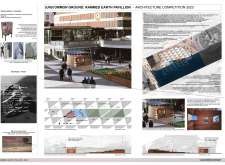5 key facts about this project
The Rammed Earth Pavilion is located in Sergels Torg, a bustling public square in Stockholm. It serves as a space for reflection and interaction with urban agriculture. The design emphasizes human scale and seeks to foster a connection between people and their environment. By incorporating elements of nature within an urban context, the pavilion encourages visitors to engage with their surroundings in a meaningful way.
Architectural Concept
The design focuses on redefining human scale in crowded urban areas. It addresses the common feeling of disconnection from the surrounding environment. The pavilion integrates urban agriculture elements such as pumpkins and herbs, allowing visitors to see how food can be produced in cities. This approach enhances the relationship between daily life and natural growth.
Materiality and Construction
Rammed earth forms the primary material of the pavilion's walls. This choice provides durability while creating a tactile connection between the structure and the earth beneath it. The walls also act as a natural climate screen, helping to regulate the internal environment. Vertical timber slats further enrich the texture of the pavilion, creating added visual interest. A light corrugated steel roof serves dual purposes: it provides shelter and facilitates rainwater collection for irrigation, emphasizing resource efficiency.
Spatial Organization
The pavilion is designed with a semi-open structure that connects its interior with the outside environment. With an area of about 19 square meters, it is scaled to human dimensions, taking into account comfort and interaction. Openings are thoughtfully placed to offer various views of the urban landscape, including notable nearby buildings. This design invites visitors to experience the interaction between architecture and nature, encouraging reflection on the space they inhabit.
Interaction with Urban Agriculture
A significant feature of the pavilion is its connection to a 100-square-meter area for urban agriculture. This space visually demonstrates the amount of land needed to sustain one person's food supply for a year, highlighting important issues such as sustainability and food security. By combining agricultural practices with urban living, the pavilion provides a platform for discussing social and ecological concerns.
The exposed rammed earth walls offer a rich textural experience, drawing visitors into a deeper relationship with both the pavilion and the surrounding environment. It is a space where architecture and nature coexist, fostering an awareness of the earth and the role it plays in everyday life.



















































